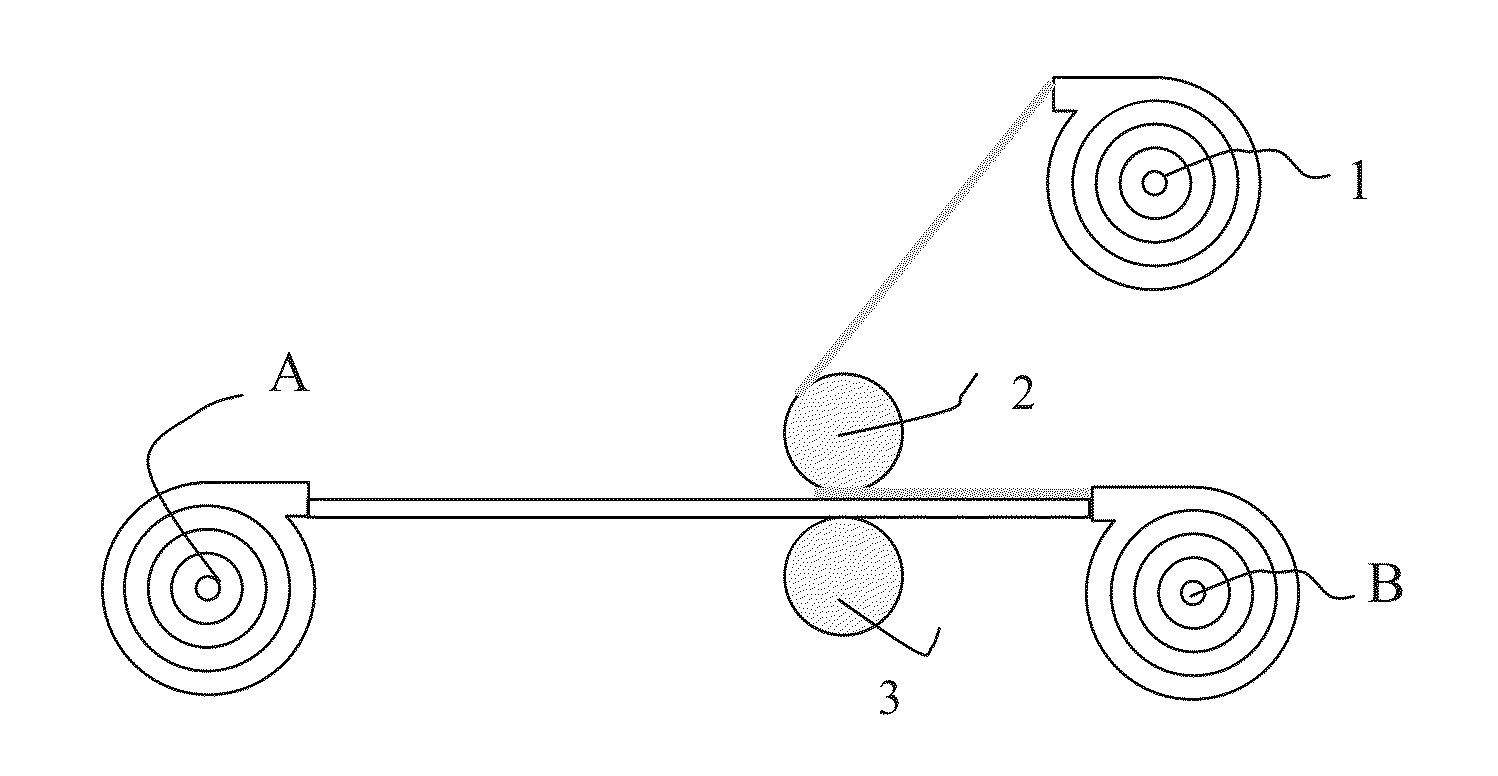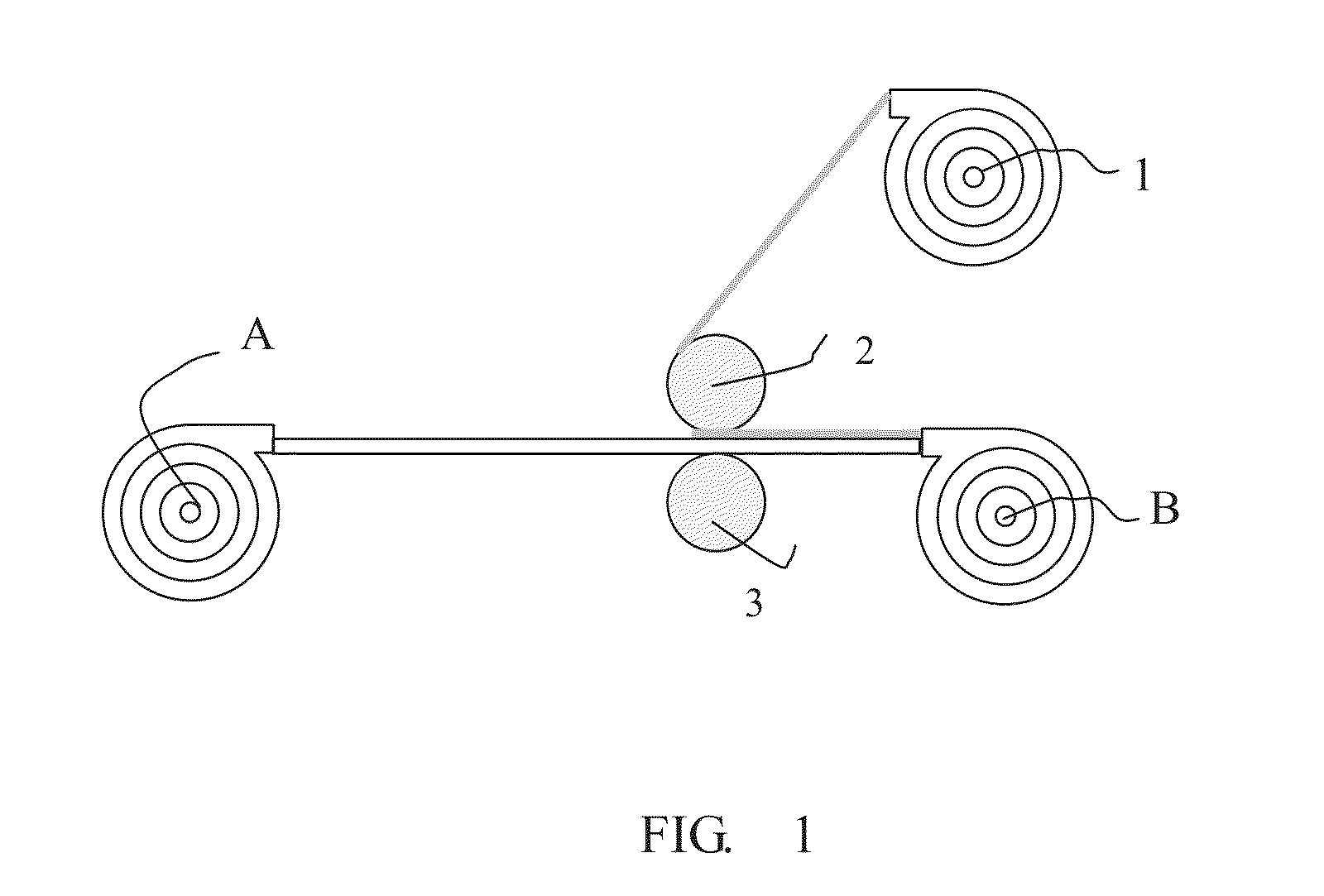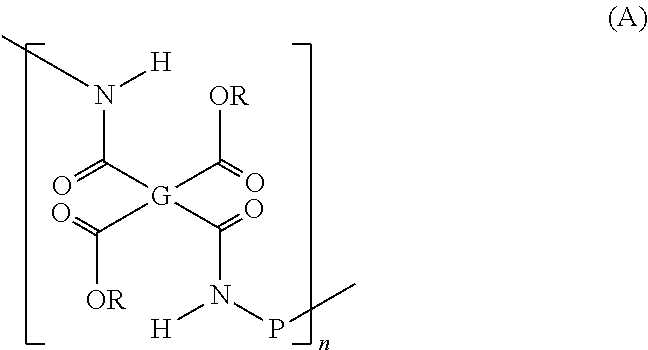Solvent-containing dry film and method for applying the same on a substrate
a technology of solvent-containing dry film and substrate, which is applied in the direction of film/foil adhesives, circuit masks, synthetic resin layered products, etc., can solve the problems of low process yield, high cost, and failure to meet the requirements of high-precision assembly, and achieves simple application process, improved heat resistance, insulativity, and chemical resistance and mechanical strength. superior
- Summary
- Abstract
- Description
- Claims
- Application Information
AI Technical Summary
Benefits of technology
Problems solved by technology
Method used
Image
Examples
synthesis example 1
Photosensitive Polyimide Precursor Resin PI-1
[0105]21.81 g (0.1 mol) pyromellitic dianhydride (referred to hereinafter as “PMDA”) was dissolved in 200 g N-methyl-2-pyrrolidone (referred to hereinafter as “NMP”). The mixture obtained was then heated up to 50° C. and agitated for reaction over 2 hours 1.161 g (0.01 mol) 2-hydroxyethyl acrylate (referred to hereinafter as “HEA”) was slowly added and then the mixture was agitated for reaction over 2 hours at a fixed temperature of 50° C. Then, 20.024 g (0.1 mol) 4,4′-oxydianiline (referred to hereinafter as “ODA”) was added to the solution, and after complete dissolution, it was further agitated for reaction over 6 hours at a fixed temperature of 50° C. to form a photosensitive polyimide precursor resin PI-1, in which the solid content is about 17 wt %. The solid content is the weight percentage of non-volatile materials in PI-1 and can be obtained, for example, by: baking the resin at 250° C. or 300° C. for 1 hour, measuring the weight...
synthesis example 2
Photosensitive Polyimide Precursor Resin PI-2
[0106]21.81 g (0.1 mol) PMDA was dissolved in 200 g NMP. The mixture obtained was then heated up to 50° C. and agitated for reaction over 2 hours. 13.01 g (0.01 mol) 2-hydroxyethyl methacrylate (referred to hereinafter as “HEMA”) was slowly added and then the mixture was agitated for reaction over 2 hours at a fixed temperature of 50° C. Then, 20.024 g (0.1 mol) ODA was added to the solution, and after complete dissolution and it was further agitated for reaction over 6 hours at a fixed temperature of 50° C. to form a photosensitive polyimide precursor resin PI-2, in which the solid content is about 21 wt %.
synthesis example 3
Photosensitive Polyimide Precursor Resin PI-3
[0107]21.81 g (0.1 mol) PMDA was dissolved in 200 g NMP. The mixture obtained was then heated up to 50° C. and agitated for reaction over 2 hours. 0.601 g (0.01 mol) isopropanol was slowly added, and then agitated for reaction over 2 hours at a fixed temperature of 50° C. Then, 32.02 g (0.1 mol) 2,2′-bis(trifluoromethyl) benzidine (referred to hereinafter as “TFMB”) was added to the solution, and after complete dissolution, it was further agitated for reaction over 6 hours at a fixed temperature of 50° C. to form a photosensitive polyimide resin precursor PI-3, in which the solid content is about 21 wt %.
PUM
| Property | Measurement | Unit |
|---|---|---|
| thickness | aaaaa | aaaaa |
| temperature | aaaaa | aaaaa |
| glass transition temperature | aaaaa | aaaaa |
Abstract
Description
Claims
Application Information
 Login to View More
Login to View More - R&D
- Intellectual Property
- Life Sciences
- Materials
- Tech Scout
- Unparalleled Data Quality
- Higher Quality Content
- 60% Fewer Hallucinations
Browse by: Latest US Patents, China's latest patents, Technical Efficacy Thesaurus, Application Domain, Technology Topic, Popular Technical Reports.
© 2025 PatSnap. All rights reserved.Legal|Privacy policy|Modern Slavery Act Transparency Statement|Sitemap|About US| Contact US: help@patsnap.com



